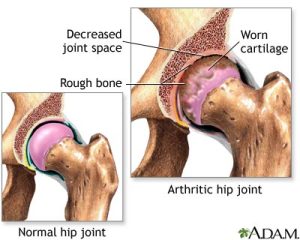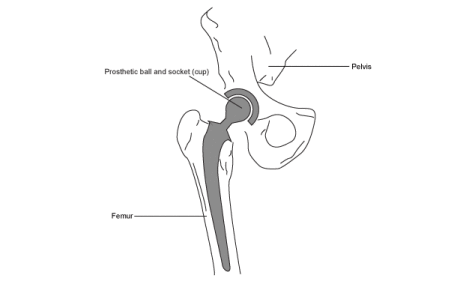
Total Hip Replacement
When the cartilage in the hip joint wears away, patients can experience a great deal of pain, limited motion and decreased function. Your doctor will first prescribe medication and physical therapy. You might start to use a cane. However, when pain and function begin to affect your life, total hip replacement is an option.

Total hip replacement involves removal of the diseased parts of the bones in the hip joint. The femur (ball) is shaved down and the thigh bone is prepared to accept a metal stem and ball. The acetabulum (socket) is then prepared to accept a metal cup. These pieces are fixed in place with bone cement or with a "press fit," so that the bone can grow into the surfaces of the metal implants. New bearing surfaces replace the worn-out cartilage in the joint. Bone spurs are removed to improve motion.
After surgery, the patient will stay in the hospital for three or four days, depending on medical conditions. Many people go to a rehabilitation facility for a short time after surgery. Most of the time a walker is used for a few weeks until initial healing occurs and strength returns.
Antibiotics are given around the time of surgery to protect against infection. Blood thinners are used to protect against blood clots. Pain medication is used to minimize discomfort.
What are the bearing surfaces? What are the materials in the hip implants?
Bearing surfaces allow the joint to slide and roll. In a total hip replacement, there are many options. The most commonly used surfaces are metal for the ball and high grade medical polymer, polyethylene (a fancy plastic) for the socket. These surfaces work very well for most people. There have been recent advances in the materials which have drastically reduced their wear. However, the plastic does eventually wear out and might require revision in the future. Metal on metal bearing surfaces experience almost no wear over time. With metal on metal surfaces, the concentration of metal ions in the blood has been found to increase. This increase does not appear to have any ill effects, but it is still being studied. Ceramic implants are also available. These experience almost no wear but can be cracked with extreme forces.
Most hip stems and sockets are made from titanium and stainless steel (cobalt chrome). There are many different types and designs for these implants. Each type has advantages and disadvantages.
What is a leg length difference?
When a total hip replacement is performed, your surgeon will do everything possible to make your legs exactly the same length. However, sometimes the operated leg will need to be lengthened slightly in order to make the hip more stable. Usually, the increase in length is very small. If the difference is bothersome, a shoe insert can be used to make the legs equal. If the operated leg is already longer than the other leg, it is nearly impossible to shorten that leg without significantly changing the procedure for your hip replacement.
Why do I need to be careful with my new hip?
Because the hip capsule and muscles need to be divided to perform surgery and because the hip implant is a man-made design, an artificial hip is more likely to come out of the socket than is a natural hip. This is true for any surgical approach to the hip. For this reason, your physical therapist will teach you about certain positions to avoid during your early recovery. Deep hip flexion and twisting are the most common reason for dislocating an artificial hip. It is important to be mindful of these positions.
If you dislocate your hip, it can be put back in place. Sometimes this requires sedation or anesthesia. Should you dislocate, go to the Emergency Department and have them call your surgeon. If this happens, please also make sure to get copies of any x-rays that are performed to bring them to Dr. Lajam.
What about sexual activity after hip replacement?
Hip replacement patients can enjoy a healthy sexual relationship. Of course, certain positions ought to be avoided or adjusted for your safety. Your doctor and therapist can discuss this with you before surgery.

